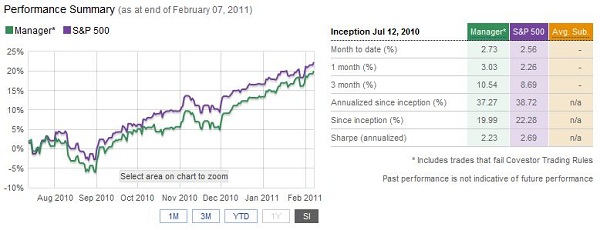Author: Bristlecone Value Partners, LLC
Covestor model: Large Cap Value
Disclosure: Long PFE, WAG, WY, EOG, HOG, XOM, MXIM, CX, LM, NSRGY, MMI

The portfolio got off to a good start in January, rising 3% versus 2.4% for the S&P 500. The best performing sectors were information technology, consumer discretionary, and financials. Industrials and materials were decliners. The portfolio’s top performers were Weyerhauser (+22.5%), EOG Resources (+16.6%), Harley Davidson (+14.4%), Exxon Mobil (+10.3%), and Maxim (+9.3%). The top decliners were Cemex (-11.6%), Legg Mason (-8.7%), Nestle (-7.8%), and Motorola Mobility (-4.2%).
During the month, we reduced our investment in Walgreen (WAG). Once again, the reason was the share price approaching our assessment of the value of the company, not due to any specific concerns.
Despite the rally in share prices of the past few months, there are still some companies in the portfolio that are trading at significant price-to-value discounts. One that we would like to highlight is Pfizer (PFE). This investment is a good illustration of why we felt that the recent bear market provided some great investment opportunities among large capitalization, high quality companies. Although “quality” is in the eye of the beholder, few would disagree in Pfizer’s case. The company benefits from sustainable competitive advantages: the largest economies of scale in the industry, a portfolio of patented drugs and large financial resources that are needed to absorb what are largely fixed costs from the drug approval process. It also generates a lot of free cash flow and has cash in excess of its long term debt.
The concerns that have been driving the stock valuation to record lows have to do with patent expirations, mostly Lipitor’s in 2011. We believe that these losses are already more than baked in the current stock price. We also feel that Pfizer’s cost structure is not as lean as it could be.
Through a combination of cost cuts, debt reduction, share repurchase, and opportunistic acquisitions, Pfizer should be able to more than offset the loss in earnings to generic competition. In the meantime, the shares trade at just over 8 times 2011 estimates, and we’re paid more than 4% in dividends to wait. We can be patient.

